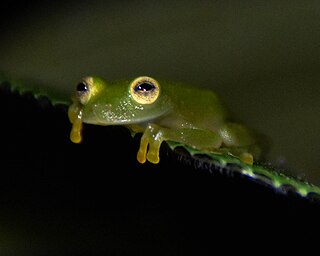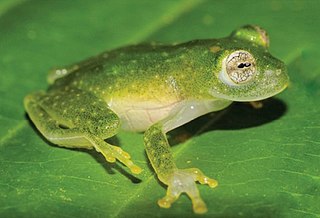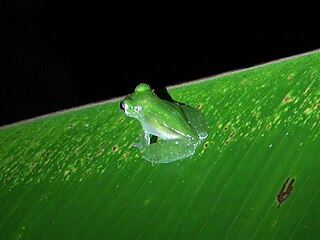
The glass frogs belong to the amphibian family Centrolenidae, native to the Central American Rainforests. The general background coloration of most glass frogs is primarily lime green, the abdominal skin of some members of this family is transparent and translucent, giving the glass frog its common name. The internal viscera, including the heart, liver, and gastrointestinal tract, are visible through the skin. When active their blood makes them visible; when sleeping most of the blood is concealed in the liver, hiding them. Glass frogs are arboreal, living mainly in trees, feeding on small insects and only coming out for mating season. Their transparency conceals them very effectively when sleeping on a green leaf, as they habitually do. However, climate change and habitat fragmentation has been threatening the survival rates of the family.

The Tropical Andes is northern of the three climate-delineated parts of the Andes, the others being the Dry Andes and the Wet Andes. The Tropical Andes' area spans 1,542,644 km2 (595,618 sq mi).

Nymphargus grandisonae is a species of frog in the family Centrolenidae. It is found in Andes of Colombia and Ecuador. Its natural habitat is tropical moist montane forest ; larvae develop in streams and still-water pools. Its habitat is threatened by habitat loss, introduced fish, and agricultural pollution, but it is still a common species not considered threatened by the IUCN.
"Centrolene" petrophilum is a species of frog in the family Centrolenidae. Also called the Boyaca Giant Glass Frog.

Centrolene prosoblepon is a species of frog in the family Centrolenidae, commonly known as the emerald glass frog or Nicaragua giant glass frog. This species can be found in Ecuador, Colombia, Panama, Costa Rica, Nicaragua, and Honduras. Its natural habitats are lowland tropical forests and montane cloud forests. It is a nocturnal species occurring in low vegetation in mature forests only. It is not considered threatened overall by the IUCN although deforestation and pollution are potential threats, as is chytridiomycosis.

Cochranella euknemos, sometimes known as the San Jose Cochran frog, is a species of frog in the family Centrolenidae. It is found in central Costa Rica and south/eastward to Panama and to the western flank of the Cordillera Occidental in Colombia. Some Colombian records might apply to Cochranella mache.

Cochranella granulosa is a species of frog in the family Centrolenidae. It is found in Costa Rica, Honduras, Nicaragua, and Panama.

Hyalinobatrachium chirripoi is a species of frog in the family Centrolenidae. It is found in extreme northern Ecuador, northwestern Colombia, Panama, and Costa Rica, as well as in Honduras. The specific name chirripoi refers to the Chirripó Indians inhabiting the area of the type locality, Suretka in the Talamanca canton of Costa Rica. The common name Suretka glass frog has been coined for it.

Hyalinobatrachium colymbiphyllum, also called the bare-hearted glass frog, plantation glass frog and the cricket glass frog, is a species of frog in the family Centrolenidae that is found in moist forests, often near streams, in countries in Central America and South America. They are small, green frogs with many similarities to other glass frogs, however, they have the most transparent undersides of any glass frogs. Their transparent undersides make them ideal bio-indicators for how global warming and other threats are affecting the animals in the forests.
Hyalinobatrachium ibama is a species of frog in the family Centrolenidae. It is found in the Cordillera Oriental, Santander Department, Colombia, and in Barinas, Venezuela.
Hyalinobatrachium orientale is a species of glass frog in the family Centrolenidae. It is found on the island of Tobago and in eastern Venezuela. Its common name is eastern glass frog. The Tobagonian population has been described as subspecies Hyalinobatrachium orientalis tobagoensis(Hardy, 1984). The latter is sometimes referred to as Tobago glass frog. H. orientale is distributed throughout the Central Eastern ranges of the Cordillera de la Costa in Venezuela and Tobago Island with an altitudinal range of 190 to 1200 meters.

Hyalinobatrachium taylori is a species of frog in the family Centrolenidae. Its common name is Taylor's glass frog, and in Spanish, ranita de cristal de Taylor. It may represent at least two distinct species.

Hyalinobatrachium valerioi, sometimes known as the La Palma glass frog, is a species of frog in the family Centrolenidae. It is found in central Costa Rica and south to Panama and the Pacific lowlands and slopes of western Colombia and Ecuador; also in the Magdalena River Valley of Colombia.

Agalychnis saltator, also known as the parachuting red-eyed leaf frog and misfit leaf frog, is a species of frog in the subfamily Phyllomedusinae. It is found in the Caribbean lowlands from north-eastern Honduras to eastern-central Costa Rica at elevations of 15–1,300 m (49–4,265 ft) asl.

The horned marsupial frog, originally named Nototrema cornutum (Boulenger) after the first describer George Albert Boulenger in 1898), is a species of frog in the family Hemiphractidae. It is an arboreal species found in Colombia, Costa Rica, Ecuador and Panama. Its natural habitats are tropical moist lowland forests and montane cloud forests. It is threatened by habitat loss.
Telmatobius ignavus is a species of frog in the family Telmatobiidae. It is endemic to the Cordillera de Huancabamba in the Department of Piura, Peru. Common name Piura water frog has been coined for it.
The Negros forest frog is a species of frog in the family Ceratobatrachidae. It is endemic to Panay and Negros, Philippines. It has been observed between 200 and 1800 meters above sea level.

The Peralta frog, or montane leopard frog, Lithobates taylori, is a species of frog in the family Ranidae found in Costa Rica and Nicaragua.

The Hispaniolan trogon, also known as cacos is a species of bird in the family Trogonidae. It is endemic to Hispaniola in the Caribbean. It is one of the only two trogon species found in the Caribbean. It is the national bird of Haiti.

The Andean porcupine or Quichua porcupine is a species of rodent in the family Erethizontidae. It is found in the Andes of northern Ecuador and Colombia as well as in Panama. This porcupine is little known, but is probably arboreal, nocturnal and solitary like its relatives. The species is thought to be uncommon to rare and the population decreasing. It is threatened by deforestation, habitat fragmentation and agriculture.















